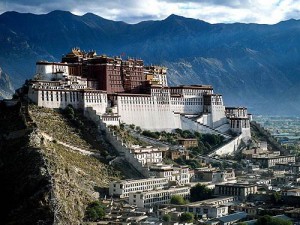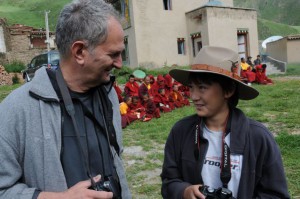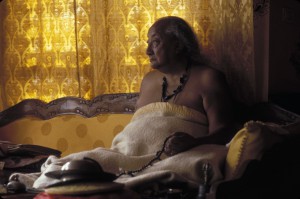Wednesday
Community ArticlesReborn in Tibet, part 4
 A Retrospective Memoir, Part 4
A Retrospective Memoir, Part 4
Lhasa 1986
by Lee Weingrad
One day I decided to visit the Potala Palace, the winter residence of the Dalai Lamas. At 11,000 feet it was an arduous climb up the 500 stairs from the village of Shol below. When I got to the ticket counter, I was told that the Palace was closed on Wednesdays. However I noticed that there was a group of Chinese VIPs being given a private tour. So I ran up to the door as they entered and did my “pity the dumb foreigner who is on a pilgrimage” routine and they let me in.
I quickly left the group and wandered alone unattended for a few hours. The Potala, meaning the home of Avalokiteshvara (who the Dalai Lamas are regarded as the incarnations of), the Buddha of wakefulness and compassion, is very large and dark from centuries of yak butter lamps seemingly covering everything in soot, both walls and thangkas. I just followed my gut. The Potala has a lot of mojo and some places had a very strong presence about them. It was haunting. I soon found myself in a large two-story high shrine room, smoky, with a skylight illuminating tendrils of incense smoke. The shrine had a few solid silver stupas. It was obviously something, but what I didn’t know. Just then an old monk appeared and I told him as best I could what I was doing there. He was very happy to hear this and told me this was the shrine that had the kudung, the body of the Great 5th Dalai Lama. He went to the main shrine kapala (skull cup) and offered it to me, not for keeps, but to drink from, and I did just that.
Another goal was to visit Samye, the first monastery in Tibet, created in the mid-8th century by Padmasambhava, who brought Buddhism to Tibet. He is renown as the second Buddha. To get there I needed to buy a bus ticket. At that time there were three tiers for public transportation: common Chinese, tourists and students. The students could purchase tickets at the same rate as Chinese citizens. A German woman I met loaned me her student ID. She looked nothing like me and I doubted that I could use it. The next day I waited in line at the bus depot and when my turn came, I told the clerk that I was a foreign student and produced the ID. He looked at the card, and then held up the picture next to my face. “Uh-oh,” I thought here’s where the shit hits the fan. But he just smiled and said, “er shi kuai yuan,” or 20 Chinese dollars. I obviously looked just like this woman.
The bus trip took about 2 hours from Lhasa; there were about 8 other foreigners on board. In contrast to the lack of any real expat scene in Lhasa, this group had some cohesion. It was clear that I was the only one who had any idea about this place.
We got off the bus at a kind of boat launch – there were about half a dozen shallow draft long-boats with long shafted oars that could get us across the shallow waters of the Yarlung Zangpo. I was about to cross one of Tibet’s mighty rivers.
It looked like it was a mile or so across. The backdrop were blue skies above a day-glo white cloud in the shape of Vajrayogini. I sat down with a monk who was on a pilgrimage and showed him a picture of the Vidyadhara in suit and tie. He respectfully glanced, but he didn’t know what to make of it. He took out a portable stove, some tea, tsampa and yak butter. He offered some to me – the plastic bag with butter inside had some flies in it. I thought, “well if they can live off it, so can I.”
I was wrong about the boat ride – it took about an hour. To avoid running aground, the pilot steered like a running back’s sleek broken-field running, dodging the river’s many sand bars. When we landed on the far shore, there were flat-bed trucks waiting for us. I was on the last boat and the last truck. When the truck got to the sacred ground of Samye, it could go no further and we climbed down to walk the remaining mile or so, with the river on our right. The lama pointed to a rock on the side of the road emitting spring water. He started to tell me the story, and I listened out of politeness, but I already knew it.
In the 8th Century, when Padmasambhava first arrived, he was with his retinue, and on the road was his patron, King Trisongdetsen, and his retinue. When they saw each other they just stood there, speechless. The King said to his attendant: “Tell the lama to bow to the king.” The attendant approached the attendant of Padmasambhava and relayed the message. Padmasambhava said to his attendant, “Tell the king to prostrate to me!” And so the outrageous message was conveyed to Trisongdetsen. And there was a stand-off. Just then Padmasambhava took his staff and struck a rock on the side of the road. When he hit it, water gushed out. The king prostrated to Guru Rinpoche.I washed my hair in the water. I drank it.
I was in no hurry to get to Samye. When I approached the only guest house, one of the foreigners ran up to me and cried, “The managers of the guest house are very drunk, very angry and won’t let us stay here!” This could be a problem, since there was no other place to stay. I walked into the office and saw that they were right: the two women were drunk and they were angry. They shouted, “You can’t stay here!” I reached into my bag and showed them the letter of introduction from Tai Situ Rinpoche. Instantly these ferocious tigresses became pussycats. The next question was, “Do you need help with your bags?”
The next morning, I entered the main assembly hall and shrine room. I really have no words for what happened or didn’t happen. After that I went to the Chemaling, which is where the fresco is that has the Heart Sutra in Tibetan written by Rinchen De. This is the Heart Sutra that Trungpa Rinpoche used, that his community has used for 40 years.
The building is the only round building at Samye. It was a mess inside – there were things all over the floor and cultural revolution posters in the walls – apparently this place had also, like the Jokhang, been used as a pig stye.
That afternoon I went to Hepo Ri, or Hepo Hill, as we call it in the Vidyadhara’s supplication to Padmasambhava:
Just as at Hepo Hill at glorious Samye, you oath bound devas and rakshasas,
So utterly destroy these obstacles of maras….
This was the place where Guru Rinpoche subjugated the demonic negative powers that were obstacles to proliferating the teachings of awake, and commanded them to become protectors of the doctrine. I wanted to go there.
So up the hill I walked. About halfway up I saw the two guesthouse managers coming towards me. But one was unconscious and being carried by the other. The conscious one was very drunk. I said hello. She hardly noticed me.
Nothing special happened when I reached the shrine at Hepo Hill summit. No devas descended from the sky, nor were there cosmic flashes of wisdom. For me, in the years to come, it just made the chant that alludes to the place alive and not something I had to imagine. It made it seem more real that Guru Rinpoche was a real man who was born, walked this earth and died. From a very primitive point of view, I was walking in the footsteps of this Buddha. And that, I thought is part of the meaning of Samye – it’s not a monastery, it’s a mandala. And like any mandala, how you enter, how you relate to it, how you find your place in it, is the point. Maybe the only point.
~~
 Lee Weingrad, also known as Wangli, was born in New York City and is a product of a middle class Jewish family and suburban New York City public schools. In 1972 he met Chogyam Trungpa Rinpoche and has been a student of his ever since. In 1986 he took his first trip to abroad: to Tibet, journeying overland from the Nepal border. He lives with his wife Wang Wenjing and children in Beijing. Meeting Trungpa Rinpoche’s eldest son, Sakyong Mipham Rinpoche, in Kathmandu, the two decided to form Friends of Surmang, to bring some help to Surmang Tibetans in the form of clinics, hospitals and other kinds of community development. Lee has transitioned away from English teaching to concentrate on the Surmang Foundation’s work fulltime. Learn more about the Surmang Foundation here.
Lee Weingrad, also known as Wangli, was born in New York City and is a product of a middle class Jewish family and suburban New York City public schools. In 1972 he met Chogyam Trungpa Rinpoche and has been a student of his ever since. In 1986 he took his first trip to abroad: to Tibet, journeying overland from the Nepal border. He lives with his wife Wang Wenjing and children in Beijing. Meeting Trungpa Rinpoche’s eldest son, Sakyong Mipham Rinpoche, in Kathmandu, the two decided to form Friends of Surmang, to bring some help to Surmang Tibetans in the form of clinics, hospitals and other kinds of community development. Lee has transitioned away from English teaching to concentrate on the Surmang Foundation’s work fulltime. Learn more about the Surmang Foundation here.


















May 27, 2013
Reply
Thank you, Lee. Thank you for letting us wash our hair and drink the water along the way.
May 27, 2013
Reply
Wonderful. Reading this gives us a vicarious pilgrimage. I hope there is at least a fifth episode! Thank you, Lee.